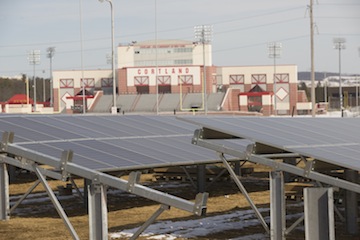
05/01/2015
SUNY Cortland isn’t just dominating the State University of New York Athletic Conference (SUNYAC) in sports.
The federal Environmental Protection Agency (EPA) this week named Cortland the SUNYAC’s green power champion, recognizing the College’s commitment to using and promoting renewable energy.
SUNY Cortland was named the 2014-15 conference leader in the EPA’s College and University Green Power Challenge for using more renewable energy than any of the 10 schools in the SUNYAC.
“EPA applauds SUNY Cortland’s accomplishment as the SUNY Athletic Conference’s largest green power user in the College and University Green Power Challenge,” said James Critchfield, program director of EPA’s Green Power Partnership. “By choosing to use green power, SUNY Cortland is cutting its carbon footprint and setting an example for others to follow.”
SUNY Cortland was the first school in the 64-campus SUNY system to get all of its electricity — 100 percent — from renewable sources such as solar, geothermal, wind and hydropower. Its 3,600-panel solar energy project, the first of its kind on any public college campus in New York, is considered a model for other state institutions.
Dragon Hall, the campus’ newest residence building, was the first structure of its kind in New York state to receive the highest possible rating for sustainability by the U.S. Green Building Council.
“Our College is deeply committed to reducing the use of fossil fuels and playing a leadership role in the green economy of the future,” SUNY Cortland President Erik J. Bitterbaum said. “We are grateful for this recognition of our efforts by the nation’s top environmental agency.”
Since 2006, EPA’s Green Power Partnership has tracked and recognized the collegiate athletic conferences with the highest combined green power use in the nation. The Individual Conference Champion Award recognizes the school that has the largest individual use of green power within a qualifying conference.
Green power is zero-emissions electricity that is generated from environmentally preferable renewable resources such as wind, solar, geothermal, biomass and low-impact hydro. Using green power helps accelerate the development of new renewable energy capacity nationwide and helps users reduce an institution’s carbon footprint.
The Green Power Partnership is a voluntary program that encourages organizations to use green power as a way to curtail the environmental impacts associated with electricity use. The partnership currently has nearly 1,300 partner organizations voluntarily using billions of kilowatt-hours of green power annually. Partners include a wide variety of leading organizations such as Fortune 500 companies, small and medium sized businesses, local, state and federal governments, and colleges and universities.
SUNY Cortland was the first SUNY campus to join the partnership.